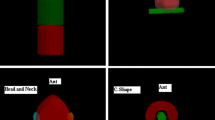Abstract
The aim of this study was to generate a local confidence limit (CL) for intensity modulated radiation therapy (IMRT) and volumetric modulated arc therapy (VMAT) techniques used at Waikato Regional Cancer Centre. This work was carried out based on the American Association of Physicists in Medicine (AAPM) Task Group (TG) 119 report. The AAPM TG 119 report recommends CLs as a bench mark for IMRT commissioning and delivery based on its multiple institutions planning and dosimetry comparisons. In this study the locally obtained CLs were compared to TG119 benchmarks. Furthermore, the same bench mark was used to test the capabilities and quality of the VMAT technique in our clinic. The TG 119 test suite consists of two primary and four clinical tests for evaluating the accuracy of IMRT planning and dose delivery systems. Pre defined structure sets contoured on computed tomography images were downloaded from AAPM website and were transferred to a locally designed phantom. For each test case two plans were generated using IMRT and VMAT optimisation. Dose prescriptions and planning objectives recommended by TG119 report were followed to generate the test plans in Eclipse Treatment Planning System. For each plan the point dose measurements were done using an ion chamber at high dose and low dose regions. The planar dose distribution was analysed for percentage of points passing the gamma criteria of 3 %/3 mm, for both the composite plan and individual fields of each plan. The CLs were generated based on the results from the gamma analysis and point dose measurements. For IMRT plans, the CLs obtained were (1) from point dose measurements: 2.49 % at high dose region and 2.95 % for the low dose region (2) from gamma analysis: 2.12 % for individual fields and 5.9 % for the composite plan. For VMAT plans, the CLs obtained were (1) from point dose measurements: 2.56 % at high dose region and 2.6 % for the low dose region (2) from gamma analysis: 1.46 % for individual fields and 0.8 % for the composite plan. All these CLs were well within the TG119 recommended bench marks. Based on these analysis which were performed in line with the TG119 recommendations, it is evident that the local clinic has commissioned IMRT and VMAT techniques with adequate accuracy. These results compliment our clinical confidence of using IMRT and VMAT routinely and expanding to different clinical sites.











Similar content being viewed by others
References
Intensity-modulated radiation therapy: the state of the art Edited by Jatinder R. Palta and T.Rockwell Mackie. AAPM Medical Physics Monograph No. 29
Otto K (2008) Volumetric modulated arc therapy: IMRT in a single gantry arc. Med Phys 35(1):310–317
Memorial Sloan-Kettering Cancer Center (2003) A practical guide to intensity-modulated radiation therapy. Medical Physics Publishing, Madison
Alber M et al (2008) Guidelines for the verification of IMRT. ESTRO, Brussels
Ling CC, Zhang O, Archambault Y et al (2008) Commissioning and quality assurance of rapid arc radiotherapy delivery system. Int J Radiat Oncol Biol Phys 72(2):575–581
LoSasso T, Chui CS, Ling CC (2001) Comprehensive quality assurance for the delivery of intensity modulated radiotherapy with multileaf collimator used in dynamic mode. Med Phys 28(11):2209–2219
Ezzell GA, Gavin JM, Low D et al (2003) Guidance document on delivery, treatment planning, and clinical implementation of IMRT: report of the IMRT subcommittee of the AAPM Radiation Therapy Committee. MedPhys 30(8):2089–2115
Ezzell GA, Burmeister JW, Dogan N et al (2009) IMRT commissioning: multiple institution planning and dosimetry comparisons, a report from AAPM task Group 119. Med Phys 36(11):5359–5373
Mynapati DK, Yaparpalvi R, Hong L et al (2012) Application of AAPM TG119 to volumetric arc therapy (VMAT). J Appl Clin Med Phys 13(5):108–116
Rapid Arc 10 operations rev.3.0: training manual from Varian Medical Systems, Palo Alto, CA
Feuvret L, Noel G, Marzeron JJ, Bey P (2006) Conformity index: a review. Int J Radiat Oncol Biol Phys 64(2):333–342
Clivio A, Fogliata A, Franzetti-Pellanda A et al (2009) Volumetric modulated arc radiotherapy forcarcinoma of the anal canal: a treatment planning comparison with fixed field IMRT. Radiother Oncol 92(1):118–124
McCurdy BM, Luchka K, Pistorius S (2001) Dosimetric investigation and portal dose image prediction using an amorphous silicon electronic portal imaging device. MedPhys 28(6):911911–911924
OmniPro-I’MRT version 1.7. User’s guide from IBA Dosimetry Germany
Rana S, Rogers K, Lee T, Reed D, Biggs C (2013) Verification and dosimetric impact of Acuros XB algorithm for stereotactic body radiation therapy (SBRT) and rapidarc planning for non-small-cell lung cancer (NSCLC) patients. Int J Med Phys 2:6–14
Han T, Mourtada F, Kisling K, Mikell J, Followill D, Howell R (2012) Experimental validation of deterministic Acuros XB algorithm for IMRT and VMAT dose calculations with the Radiological Physics Center’s head and neck phantom. Med Phys 39:2193–2202
Acknowledgments
This work was supported by Waikato District Health Board. We acknowledge the encouragement from Mark Holmes, Chief Physicist at Waikato District Health Board and the entire Medical Physics team at Waikato District Health Board. We also extent our sincere thanks for the support from Koki Mugabe, Senior Physicist at Auckland Radiation Oncology, Auckland.
Author information
Authors and Affiliations
Corresponding author
Rights and permissions
About this article
Cite this article
Thomas, M., Chandroth, M. Local confidence limits for IMRT and VMAT techniques: a study based on TG119 test suite. Australas Phys Eng Sci Med 37, 59–74 (2014). https://doi.org/10.1007/s13246-014-0241-5
Received:
Accepted:
Published:
Issue Date:
DOI: https://doi.org/10.1007/s13246-014-0241-5




